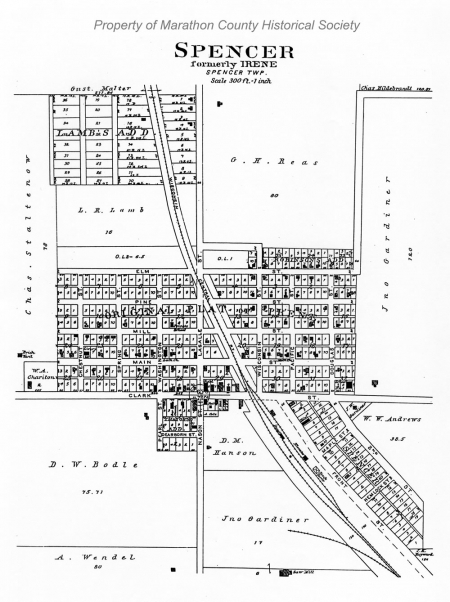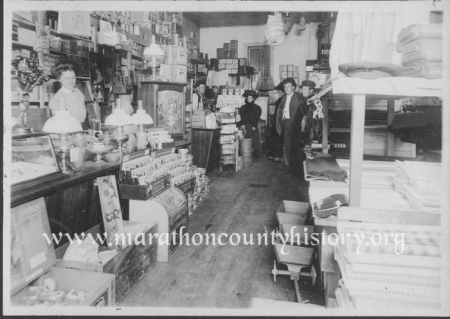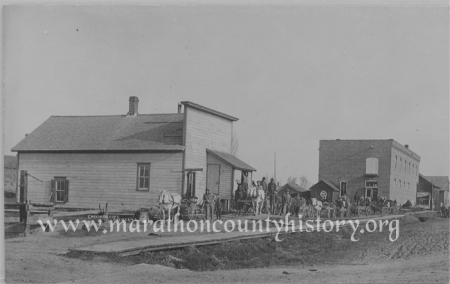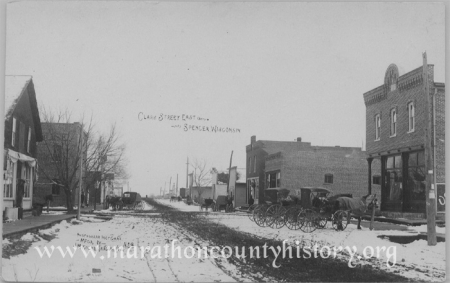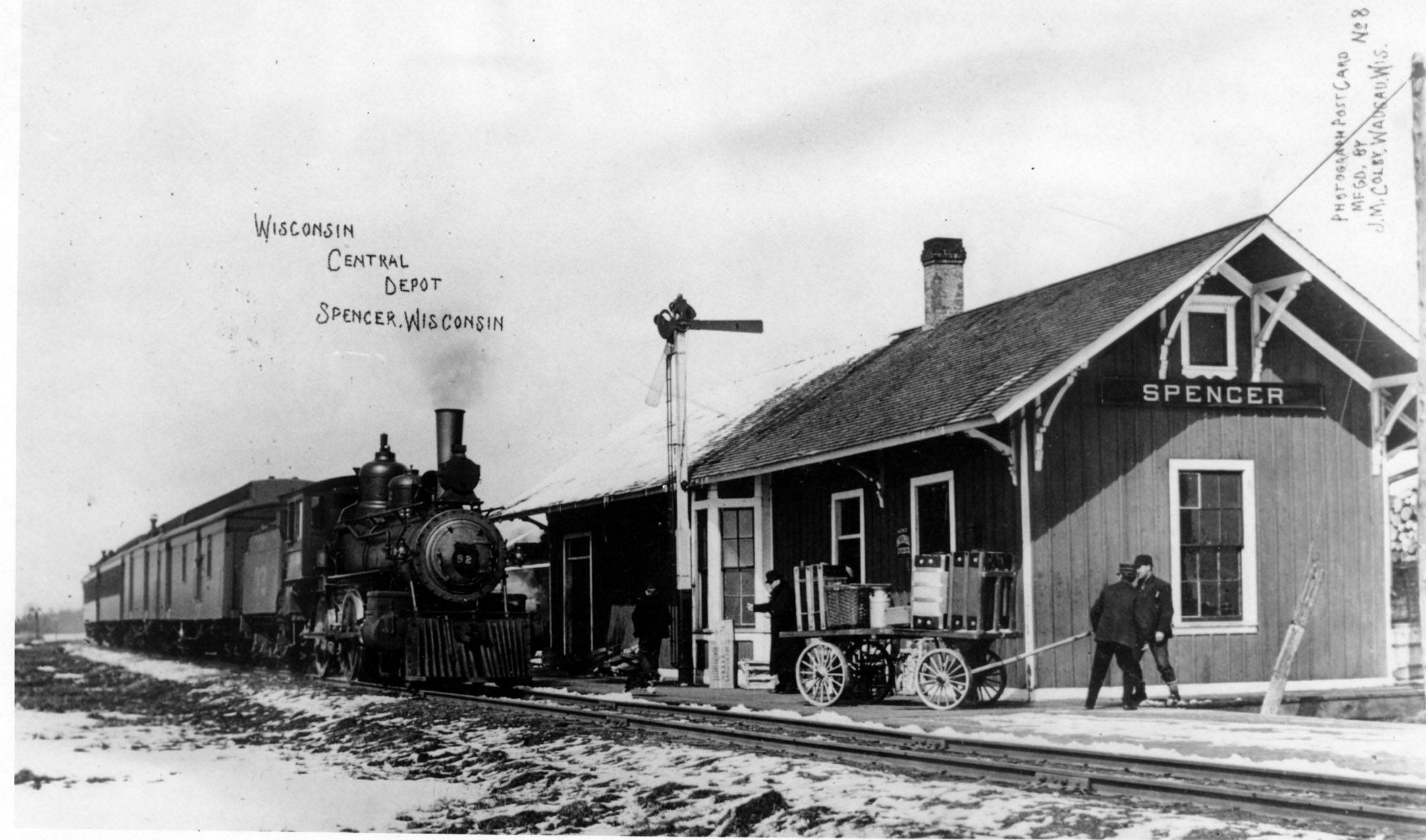Search our Places Database
Spencer, Village of
Return To List of Locations | Back to Search
For more information on this location, please contact our research library.
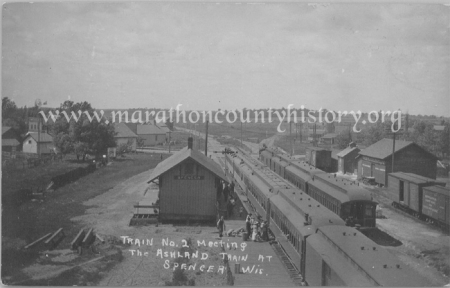
Author:
Mary Forer
Location:
T. 26 N. - R. 3 E., Sec. 5,6,7,8, Township of Spencer
Formallized:
1904
Background:
Population: 1905-311, 2000-1,932.
The Village of Spencer was first known as Waltham. As early as 1877 there were four large sawmills situated on the site of the present village. The sawmills pulled out one after another as the timber vanished, until all had disappeared. But in nearly the same degree as the mills and the mill population decreased, the farming settlement increased, and while the village lost, the town gained year after year, and Spencer village became a good country village.
First Public Official:
George Farrington, County Board Representative
Post Office Established:
1874
First Postmaster:
John K. Hayward
About The Post Office:
The name was changed from Waltham to Spencer on July 27, 1874 by John K. Hayward.
Railroad:
John K. Hayward, the second white settler to come to the area, was superintendent for the building of the road bed for the Wisconsin Central Railroad. He built a shanty and began brushing six miles of railroad northward from Section 35. Near this shanty he erected a depot made of ties and called the place Waltham. The depot made of ties was later replaced by a larger wooden structure located to the North. After it burned down another was built east of the tracks and in 1901 was moved west of the tracks. The depot was a busy place and many times it was filled to capacity as passengers waited to change trains. People in the area were known to spend Sunday afternoons at the depot observing all of the activity.
See Township of Spencer
Churches:
In 1873, the Rev. W. C. Schilling of Stevens Point came to Spencer on a mission trip. He was the first Lutheran pastor to serve settlers in the area. Services were held in a log school house on the Naatz farm north of Spencer. St. John's congregation was organized on October 27, 1878.
The first Catholic church was built in 1883 on the east side of Spencer. A fire destroyed this church in 1886.
Trinity Lutheran Church was organized on May 21, 1882. The first new church home was dedicated in 1896.
There is no record as to the organization of the United Methodist Church, but it must have been prior to the building of the first church c. 1879. A fire destroyed this church building in 1886.
The Baptist church held religious services in Spencer as early as 1875 in the school basement. A church building was built on Clark Street in 1879.
Schools:
Classes were held in a small building west of the railroad tracks in the fall of 1874. The first school building was erected in 1875 for School District 1, Town of Spencer. This building was replaced several times over the years for many different reasons. In 1915 and 1916 a two-story brick school building was built on the same site to serve as both the grade school and the high school. This facility served the community until 1951 when new facilities were added.
Business:
The following are examples of early businesses:
General stores - Most mill owners built small stores that handled general merchandise such as groceries, clothing, dry goods, and sometimes footwear.
Hotels - Built in 1874, the first hotel, the Pioneer House, was destroyed by fire in 1884. The first owner was Oscar Lattin.
Meat Markets - M. Eichert and Thomas Norton had meat markets in the early 1870s.
Cabinet shop - John Affolter opened a shop in December 1881, put in a stock of cabinet ware and built cabinets to specifications.
Millinery & dressmaking - Mrs. C. K. Richardson's store was first in the front part of her home. Then she built a shop on the same street as her home, Main Street. An advertisement for her store on June 9, 1881, announced, "Fancy goods and a 5 cent table a speciality."
Harness shops - John Davel advertised on December 23, 1881, "Stock of double or single harnesses or can make one to suit."
Express and dray service - As railroad transportation increased, so did the need for more express and delivery service. In 1881, Frank Cressy established what he called the "Knickerbocker Transfer Line" with his office in his wagon.
Photographer - E. Fleming had a shop on West Main Street and advertised in a June 1882 Spencer paper, "Old pictures copied and enlarged - pictures framed to order."
Barber shops - an example of one: William Walker operated the Palace Barber Shop in December 1883.
Neidlein Implement Shop - a wagon and woodwork shop, established June 1884 and owned by John Neidlein.
Spencer State Bank - first building erected in 1908.
Farmers Cooperative Company - organized August, 1912.
Jewelry shop - A. B. Haven owned and operated the first jewelry shop.
S. D. Graves & Son - a furniture business
Industry:
See Township of Spencer
Stories:
"Scorched Again! Nearly Half the Town Burned" was the headline in the Spencer Tribune on Monday, August 9, 1886. Reportedly, several days prior to the August 8, 1886 disaster, a fire had broken out on the property of D. F. Cressy which was located southwest of the village. As the days passed, the fire moved closer to the south side of the village. On Sunday, August 8, 1886, it roared into the village, burning many buildings, churches, schools and houses along the way. Mayor Upham and the citizens of Marshfield brought supplies and offers of homes for the victims. Although Spencer did not die as many lumber towns had after such an experience, the fire did bring the beginning of the end of the lumber business in the area.

